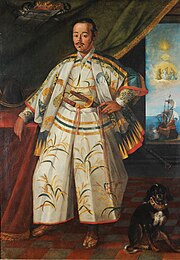San Juan Bautista (ship)
 The Japanese-built 1613 galleon San Juan Bautista, in Ishinomaki, Japan (replica). The Japanese-built 1613 galleon San Juan Bautista, in Ishinomaki, Japan (replica).
| ||
| Career | ||
|---|---|---|
| Builder: | Sendai Daimyo | |
| Laid down: | 1613 | |
| Launched: | 1613 | |
| Commissioned: | September 1613 | |
| Decommissioned: | ||
| Fate: | Sold | |
| Specifications | ||
| Displacement: | 500 tons | |
| Length: | 55.35 m (LOA) | |
| Beam: | 11.25 m | |
| Draught: | 3.80 m | |
| Propulsion: | 3-masted sailboat | |
| Complement: | 180 | |
| Armament: | 16 cannons | |
San Juan Bautista (“St John Baptist”) (originally called Date Maru, 伊達丸 in Japanese) was one of Japan's first Japanese-built Western-style sail warships. She crossed the Pacific in 1614. She was of the Spanish Galleon type, known in Japan as Kuro-Fune (,黒船, lit. “Black ships”), or Nanban-Sen (南蛮船, lit. “Southern Barbarian ships”).
She transported a Japanese embassy of 180 people headed by Hasekura Rokuemon, and accompanied by the Spanish friar Luis Sotelo, to the Spanish possessions of Mexico. The ultimate mission for the embassy was to go on to Europe, which she reached in 1615, before going back to Japan.
Construction
San Juan Bautista was built in 1613 by Date Masamune, the Daimyo of Sendai in northern Japan, in Tsuki-No-Ura harbour (Ishinomaki, Miyagi). The project had been approved by the Bakufu, the Shogun's government in Edo.
The Shogun already had had two smaller ships (80 and 120 tons) built for him by the English pilot William Adams, and the larger one, the San Buena Ventura, was given to Spanish shipwrecked sailors for their return to Mexico in 1610. The Shogun also issued numerous permits for Red seal ships, destined to Asian trade and incorporating many elements of Western ship design.
San Juan Bautista is reported to have required 45 days work, with the participation of technical experts from the Bakufu, 800 shipwrights, 700 smiths, and 3000 carpenters. Two Spanish men are also reported to have participated to the endeavour: the friar Luis Sotelo, and the Spanish captain Sebastian Vizcaino.
These efforts were seen with disapproval by the Spanish government in Manila, and Los Rios Coronel suggested that Luis Sotelo should not be allowed into Japan any further (C.R. Boxer).
Two trans-pacific round-trips

Upon completion, the ship left in 28 October 1613 for Acapulco in Mexico, with around 180 people on board, consisting of 10 samurai of the Shogun (led by the Minister of the Navy Mukai Shooken), 12 samurai from Sendai, 120 Japanese merchants, sailors, and servants, and around 40 Spaniards and Portuguese. The ship arrived in Acapulco on 25 January 1614 after three months.
After a year in Acapulco, the ship returned to Japan in April 1615, as Hasekura continued to Europe. It seems that around 50 specialists in mining and silver-refining were invited to Japan on this occasion, so that they could help develop the mining industry in the Sendai area.
In September 1616, the San Juan Batista headed again to Acapulco, at the request of Luis Sotelo. She was sailed by Captain Yokozawa Shogen, but the trip went wrong and around 100 sailors died en route. Sotelo and Hasekura met in Mexico for the final trip back to Japan. In April 1618 the ship arrived to the Philippines, where she was sold to the Spanish government there, with the objective of building up defenses against the Dutch. Hasekura returned to Japan in 1620.
By the time Hasekura came back, Japan had changed quite drastically: Christianity was being eradicated since its interdiction in 1614, and Japan was moving towards a period of Seclusion. Because of these persecutions, the trade agreements with Mexico he had been trying to establish were also denied. In the end, his embassy seems to have had little results, and he died two years later of illness.

San Juan Bautista today
A new San Juan Bautista was reconstructed in 1993 on the basis of the records of the House of Date. Although the exact blueprints have not been found, the ship’s dimensions were recorded properly, permitting the reconstitution. The ship is currently on display in a theme park in northern Japan, close to the location where she was originally built.
See also
- List of ships of the Japanese Navy
- Red seal ships
- Ship replica (including a list of ship replicas)
References
- “The Christian century in Japan 1549-1650” C.R. Boxer ISBN 1857540352
- “Quand le Japon s’ouvrit au monde” Francis Marcouin and Keiko Omoto ISBN 207053118X
